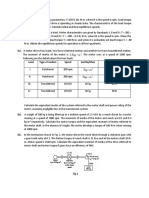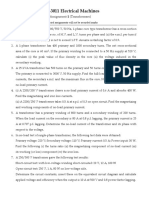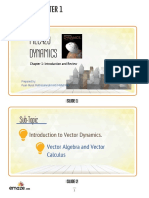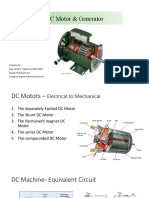Tutorial 7 - Synchronous Machines
Uploaded by
MohdFirdausTutorial 7 - Synchronous Machines
Uploaded by
MohdFirdausElectrical Power and Machines EPE491
Tutorial 5 Synchronous Machines
1.
Name the principal parts of a synchronous machine.
2.
State the 2 types of winding in a synchronous machine and briefly describe their
purposes.
3.
Why is the stator winding always connected in wye?
4.
State the 2 types of rotor used in synchronous machine and their differences.
5.
Describe the principle of operation of a synchronous generator.
6.
Describe the principle of operation of a synchronous motor.
7.
What conditions must be met before a generator can be connected to a 3
system?
8.
A 25kVA, 220V, 3 synchronous generator delivers rated kVA at a power factor of
0.8 lagging. The armature resistance is 0.2/phase and synchronous reactance is
0.8 /phase. The friction and windage losses are 460W and core loss is 610W.
Calculate the voltage regulation and efficiency at full-load.
[35.98%, 84.6%]
9.
A 3, Y-connected synchronous generator is rated at 120MVA, 13.2 kV, 0.8 power
factor lagging with 60Hz frequency. Its synchronous reactance is 0.7/phase and
armature resistance is negligible. Calculate the voltage regulation of this generator.
[34.5%]
10.
A 3 synchronous generator operates onto a 13.8kv power grid. The reactance is
5/phase. It is delivering 12MW and 6MVar (inductive) to the system. Determine:
a) Power angle (i.e. the angle between EG and VT)
b) Phase angle
c) Generated emf, EG (3)
[15.2, 26.6, 16.56kV]
11.
A 480V 60Hz, 6 pole motor draws 50A from the line at unity power factor and full
load. Assuming that the losses are negligible, calculate:
a) The output torque
b) The magnitude of the line current if the power factor is adjusted to 0.8
leading.
[331Nm, 62.5A]
12.
A 480V, 400 hp, 60Hz, 8 pole, -connected synchronous motor has a per phase
synchronous reactance of 1 and negligible armature resistance. If the friction,
windage and core losses are negligible, calculate the magnitude of Ea and Ia at
0.85 pf lagging. What is the torque produced?
[408V, 422A, 3166Nm]
D. Johari, FKE UiTM
Electrical Power and Machines EPE491
13.
A 2300 V, 100hp, 60Hz 8 pole Y-connected synchronous motor has a rated power
factor of 0.85 leading. At full load, the efficiency is 85%. The armature resistance is
1.1 /phase and the synchronous reactance is 20/phase. Find the following
quantities at full load:
a) Output torque
b) Input power
c) EA
d) Ia (armature current)
e) Mechanical Power Pm
[791.5Nm, 87.8kW, 1641V, 25.9A, 85.6kW]
14.
A 2200V, 500hp, Y-connected synchronous motor has a resistance of 0.3 /phase
and synchronous reactance of 3 /phase respectively. Determine the induced emf
per phase if the motor works on full load with efficiency of 94% and a p.f. of 0.8
leading. What is the (P + core loss)?
[1511V]
15.
A 400V, l0hp, 3-phase, Y-connected synchronous motor has a negligible armature
resistance and synchronous reactance of 100 /phase. Determine the minimum
current and corresponding induced emf for full load conditions. Assume the
efficiency is 85%.
16.
A 2400V, 2000kVA, 3-phase, -connected synchronous generator has a
synchronous reactance of 1.5/phase and negligible armature resistance. The
excitation of the generator is adjusted to generate rated voltage at no-load.
Calculate the terminal voltage when delivering rated current at 0.8 lagging p.f.
[2121.76V]
D. Johari, FKE UiTM
Electrical Power and Machines EPE491
Calculate also the equivalent resistive and reactive voltage drops:
a)
in primary terms
b)
in secondary terms
[13.66 V, 48. 31 V, 1.37 V, 4.83 V]
2.
A 20 kVA, 2400/240 V, 60 Hz transformer has the following resistance and
reactance values:
Rp = 0.8
Rs = 0.0084
Xp = 3
Xs = 0.028
Calculate the equivalent impedance of this transformer in secondary term.
3.
A 1, 100 kVA, 11000/2200 V, 60 Hz transformer has the following parameters.
R1 = 6
R2 = 0.28
Rc = 125 k
L1 = 0.08 H
L2 = 0.0032 H
Lm = 160 H
Find the equivalent circuit of the transformer referred to the low-voltage side.
[0.52 , 2.42 ]
4.
A 15 kVA 8000/230 V distribution transformer has impedance referred to the
primary of 80 + j300 . The components of the excitation branch referred to the
primary side are Rc = 350 k and Xm = 70 k. If the primary voltage is 7967 V
and the load impedance is ZL = 3.2 + j1.5, what is the secondary voltage of the
transformer? What is the voltage regulation of the transformer?
[218.8 3.1 V, 4.7 %]
5.
A 100 kVA, 1000/100 V transformer gave the following test results:
Open-circuit test (high-voltage side open) 100 V, 6 A, 400 W
Short-circuit test (low-voltage side open) 50 V, 100 A, 1800 W
a) Derive an approximate equivalent circuit referred to the high-voltage side.
b) Determine the voltage regulation at full load, 0.6 PF leading.
[2.56 %]
6.
A 2000-VA 230/115-V transformer has been tested to determine its equivalent
circuit. The results of the tests are shown below.
Open-circuit test
Voc = 230 V
Ioc = 0.95 A
Poc = 80 W
Short-circuit test
Vsc = 11.2 V
Isc = 5 A
Psc = 20.1 W
All data given were taken from the primary side of the transformer.
a) Find the equivalent circuit of this transformer referred to the low-voltage side
of the transformer.
b) Find the transformers voltage regulation at rated condition 0.8 PF lagging.
c) Determine the transformers efficiency at rated conditions and 0.8 PF lagging.
[Zeq = 0.201 +j 0.52 , XM = 65.04 , Rc = 165.31 , 1.8%, 82.19%]
D. Johari, FKE UiTM
Electrical Power and Machines EPE491
7.
The secondary winding of a transformer has a terminal voltage of vs (t) = 282.8
sin 377t V. The turns ratio of the transformer is 50:200 (a = 0.25). If the
secondary current of the transformer is is (t) = 7.07 sin 377 36.87 A, what is
the primary current of this transformer? What are its voltage regulation and
efficiency? The impedances of this transformer referred to the primary side are
Req = 0.05
Xeq = 0.225
RC = 75
XM = 20
[22.3-41.0 A, VR= 7.2%, = 93.4%]
8.
A single-phase, 10KVA, 400/1100V, 50Hz transformer has the following circuit
parameters:
ZLV = 0.82 + j0.95
ZHV = 1.2 + j1.5
ZLV = Low Voltage Impedance
ZHV = High Voltage Impedance
a) Determine the rated currents for both sides of the transformer.
b) Draw the equivalent circuit with the parameters referred to the low-voltage
side.
c) The high-voltage side is now supplying full-load current at 1000 V and 0.82
power factor lagging. Determine the voltage regulation and efficiency of the
transformer. Neglect the effect of the core.
[25 A, 9.091 A, 0.159 , 0.199 , 11.06 %, 91.75 %]
D. Johari, FKE UiTM
You might also like
- Fundamentals Of. Electrical Machines. Second Edition. M. A. Salam. Science International Ltd. Alpha Oxford, U.K.No ratings yetFundamentals Of. Electrical Machines. Second Edition. M. A. Salam. Science International Ltd. Alpha Oxford, U.K.7 pages
- LAB REPORT NO 12 (Electrical Engineering)No ratings yetLAB REPORT NO 12 (Electrical Engineering)8 pages
- Economic Load Dispatch (Optimal Power Flow) : by Adisu TeshaleNo ratings yetEconomic Load Dispatch (Optimal Power Flow) : by Adisu Teshale26 pages
- Exercise Problems Electrical Machines 291010No ratings yetExercise Problems Electrical Machines 2910109 pages
- Simulation of Some Power System, Control System and Power Electronics Case Studies Using Matlab and PowerWorld SimulatorFrom EverandSimulation of Some Power System, Control System and Power Electronics Case Studies Using Matlab and PowerWorld SimulatorNo ratings yet
- Induction Motors: The Concept of Rotor SlipNo ratings yetInduction Motors: The Concept of Rotor Slip12 pages
- Engineering Lab 5 Machine Lab Lab 1 ReportNo ratings yetEngineering Lab 5 Machine Lab Lab 1 Report9 pages
- Topic 8 - Short-Circuit and Open Circuit Test of TransformerNo ratings yetTopic 8 - Short-Circuit and Open Circuit Test of Transformer20 pages
- 25-Feb-2020 11B Converter Fed and Chopper Fed DC DrivesNo ratings yet25-Feb-2020 11B Converter Fed and Chopper Fed DC Drives16 pages
- Name: Prakash Pokhrel Roll No: 073 Bel 325 Micro Hydro Tutorial 4: Assignment 4No ratings yetName: Prakash Pokhrel Roll No: 073 Bel 325 Micro Hydro Tutorial 4: Assignment 43 pages
- Simulation of Closed Loop Control of Buck Converter Fed DC Motor DriveNo ratings yetSimulation of Closed Loop Control of Buck Converter Fed DC Motor Drive4 pages
- Chapter 1 - Introduction To Machinery Principles PDFNo ratings yetChapter 1 - Introduction To Machinery Principles PDF27 pages
- Experiment No. 13: Objective: To Investigate The Use of JFET As A Constant Current Source & As Chopper ApparatusNo ratings yetExperiment No. 13: Objective: To Investigate The Use of JFET As A Constant Current Source & As Chopper Apparatus3 pages
- Tutorial 2 - Controlled Converter Driven DC Motor PDFNo ratings yetTutorial 2 - Controlled Converter Driven DC Motor PDF5 pages
- SKEE2413 - Chapter 1 Part 2 Transformer-1No ratings yetSKEE2413 - Chapter 1 Part 2 Transformer-180 pages
- EE 340L - Experiment 6: Synchronous Generator - Operation With The GridNo ratings yetEE 340L - Experiment 6: Synchronous Generator - Operation With The Grid6 pages
- Magnetic Amplifier in Series: Operation ManualNo ratings yetMagnetic Amplifier in Series: Operation Manual6 pages
- Squirrel Cage Induction Motor Have Some AdvantagesNo ratings yetSquirrel Cage Induction Motor Have Some Advantages7 pages
- DC Machines: Version 2 EE IIT, KharagpurNo ratings yetDC Machines: Version 2 EE IIT, Kharagpur16 pages
- Electromechanics Lab: Lab Report Experiment 3: To Study Three - Phase Transformer ConnectionsNo ratings yetElectromechanics Lab: Lab Report Experiment 3: To Study Three - Phase Transformer Connections9 pages
- Question Bank With Answers: BE 8253 - Basic Electrical, Electronics and Instrumentation EngineeringNo ratings yetQuestion Bank With Answers: BE 8253 - Basic Electrical, Electronics and Instrumentation Engineering93 pages
- Ex - No.3 (A) Open Circuit Characteristics of DC Shunt GeneratorNo ratings yetEx - No.3 (A) Open Circuit Characteristics of DC Shunt Generator3 pages
- Imagine If Only One Size of Pants Were Sold in StoNo ratings yetImagine If Only One Size of Pants Were Sold in Sto4 pages
- MEC 420 Dynamics: PROG: EM 241 PART: 03 Credit HR: 3 CONTACT HR: 4 (3L+1T) Pre Requisite: MEC 412No ratings yetMEC 420 Dynamics: PROG: EM 241 PART: 03 Credit HR: 3 CONTACT HR: 4 (3L+1T) Pre Requisite: MEC 41218 pages
- QUIZ NO.1: Kinematics of Particles Problem Statement: Data & DiagramNo ratings yetQUIZ NO.1: Kinematics of Particles Problem Statement: Data & Diagram1 page
- QUIZ NO.1: Kinematics of Particles Problem Statement: Data & DiagramNo ratings yetQUIZ NO.1: Kinematics of Particles Problem Statement: Data & Diagram2 pages
- Mat455-Tutorial 7 (Sequences and Series)No ratings yetMat455-Tutorial 7 (Sequences and Series)4 pages
- 1.0 Circuit Analysis: Basic Electrical Engineering ELE290No ratings yet1.0 Circuit Analysis: Basic Electrical Engineering ELE2905 pages
- 1202 Enthusiast All Star Batch Score-II Paper- E JA100% (1)1202 Enthusiast All Star Batch Score-II Paper- E JA24 pages
- AE1343AS AE130GS 220 220 R12: Especificación Técnica Ingeniería de ProductosNo ratings yetAE1343AS AE130GS 220 220 R12: Especificación Técnica Ingeniería de Productos4 pages
- Oblique Impact With Friction and Tangential CompliNo ratings yetOblique Impact With Friction and Tangential Compli22 pages
- Flashcards - Topic 1.4 Density - CAIE Physics IGCSENo ratings yetFlashcards - Topic 1.4 Density - CAIE Physics IGCSE11 pages
- Fundamentals Of. Electrical Machines. Second Edition. M. A. Salam. Science International Ltd. Alpha Oxford, U.K.Fundamentals Of. Electrical Machines. Second Edition. M. A. Salam. Science International Ltd. Alpha Oxford, U.K.
- Economic Load Dispatch (Optimal Power Flow) : by Adisu TeshaleEconomic Load Dispatch (Optimal Power Flow) : by Adisu Teshale
- Simulation of Some Power System, Control System and Power Electronics Case Studies Using Matlab and PowerWorld SimulatorFrom EverandSimulation of Some Power System, Control System and Power Electronics Case Studies Using Matlab and PowerWorld Simulator
- Topic 8 - Short-Circuit and Open Circuit Test of TransformerTopic 8 - Short-Circuit and Open Circuit Test of Transformer
- 25-Feb-2020 11B Converter Fed and Chopper Fed DC Drives25-Feb-2020 11B Converter Fed and Chopper Fed DC Drives
- Name: Prakash Pokhrel Roll No: 073 Bel 325 Micro Hydro Tutorial 4: Assignment 4Name: Prakash Pokhrel Roll No: 073 Bel 325 Micro Hydro Tutorial 4: Assignment 4
- Simulation of Closed Loop Control of Buck Converter Fed DC Motor DriveSimulation of Closed Loop Control of Buck Converter Fed DC Motor Drive
- Chapter 1 - Introduction To Machinery Principles PDFChapter 1 - Introduction To Machinery Principles PDF
- Experiment No. 13: Objective: To Investigate The Use of JFET As A Constant Current Source & As Chopper ApparatusExperiment No. 13: Objective: To Investigate The Use of JFET As A Constant Current Source & As Chopper Apparatus
- Tutorial 2 - Controlled Converter Driven DC Motor PDFTutorial 2 - Controlled Converter Driven DC Motor PDF
- EE 340L - Experiment 6: Synchronous Generator - Operation With The GridEE 340L - Experiment 6: Synchronous Generator - Operation With The Grid
- Squirrel Cage Induction Motor Have Some AdvantagesSquirrel Cage Induction Motor Have Some Advantages
- Electromechanics Lab: Lab Report Experiment 3: To Study Three - Phase Transformer ConnectionsElectromechanics Lab: Lab Report Experiment 3: To Study Three - Phase Transformer Connections
- Question Bank With Answers: BE 8253 - Basic Electrical, Electronics and Instrumentation EngineeringQuestion Bank With Answers: BE 8253 - Basic Electrical, Electronics and Instrumentation Engineering
- Ex - No.3 (A) Open Circuit Characteristics of DC Shunt GeneratorEx - No.3 (A) Open Circuit Characteristics of DC Shunt Generator
- Power System Wide-area Stability Analysis and ControlFrom EverandPower System Wide-area Stability Analysis and Control
- Computer Aided Design of Electrical MachinesFrom EverandComputer Aided Design of Electrical Machines
- Imagine If Only One Size of Pants Were Sold in StoImagine If Only One Size of Pants Were Sold in Sto
- MEC 420 Dynamics: PROG: EM 241 PART: 03 Credit HR: 3 CONTACT HR: 4 (3L+1T) Pre Requisite: MEC 412MEC 420 Dynamics: PROG: EM 241 PART: 03 Credit HR: 3 CONTACT HR: 4 (3L+1T) Pre Requisite: MEC 412
- QUIZ NO.1: Kinematics of Particles Problem Statement: Data & DiagramQUIZ NO.1: Kinematics of Particles Problem Statement: Data & Diagram
- QUIZ NO.1: Kinematics of Particles Problem Statement: Data & DiagramQUIZ NO.1: Kinematics of Particles Problem Statement: Data & Diagram
- 1.0 Circuit Analysis: Basic Electrical Engineering ELE2901.0 Circuit Analysis: Basic Electrical Engineering ELE290
- 1202 Enthusiast All Star Batch Score-II Paper- E JA1202 Enthusiast All Star Batch Score-II Paper- E JA
- AE1343AS AE130GS 220 220 R12: Especificación Técnica Ingeniería de ProductosAE1343AS AE130GS 220 220 R12: Especificación Técnica Ingeniería de Productos
- Oblique Impact With Friction and Tangential CompliOblique Impact With Friction and Tangential Compli
- Flashcards - Topic 1.4 Density - CAIE Physics IGCSEFlashcards - Topic 1.4 Density - CAIE Physics IGCSE



















































































































